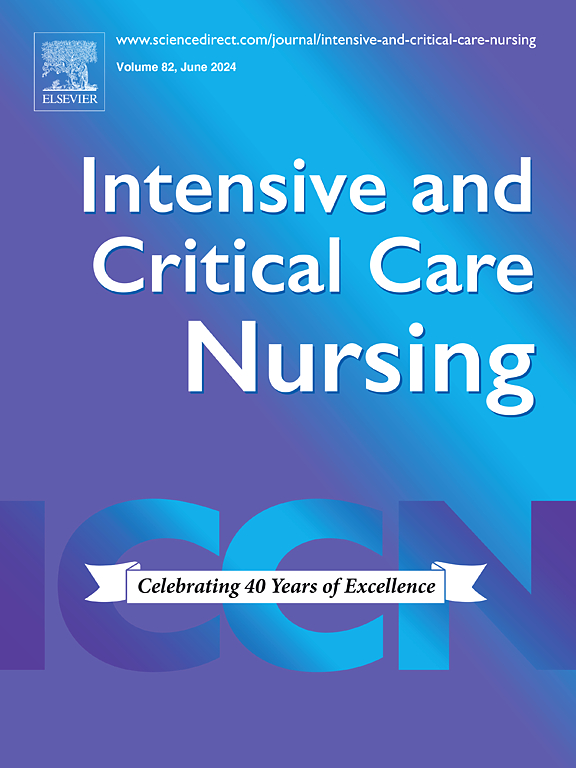Family perspectives on physical restraint practices and minimization in an adult intensive care unit: A qualitative descriptive study
IF 4.9
2区 医学
Q1 NURSING
引用次数: 0
Abstract
Objective
To explore family perspectives on physical restraint practices and their minimization in an adult intensive care unit.
Design & Methods
A qualitative descriptive study with one-on-one semi-structured interviews. A deductive content analysis approach was undertaken using the Theoretical Domains Framework.
Setting
A 20-bed medical, surgical, trauma ICU in Toronto, Canada.
Findings
Fifteen family members were interviewed. Three themes emerged: (i) barriers and facilitators to restraint minimization. Barriers noted by families included patient agitation posing risks of losing endotracheal tubes, nurse reluctance to remove restraints, lack of family involvement, limited knowledge of alternatives, and a noisy environment. Facilitators included family involvement in decision-making, timely extubation, use of less restrictive alternatives such as mittens, mandating shorter periods of restraints application, and environmental modifications; (ii) unilateral decision-making regarding physical restraint use, where clinicians made decisions with inadequate communication with families nor obtaining consent; and (iii) the emotional impact of physical restraint use, with families experiencing sadness and shock and believing the patient would feel similarly.
Conclusion
This qualitative study highlights significant issues surrounding the use of physical restraints, particularly the lack of family involvement in decision-making, the emotional toll on families, and various barriers and facilitators to minimizing restraint use. Effective communication and collaboration between clinicians and families are crucial to addressing these issues.
Implications for Clinical Practice
Our findings underscore the critical need to enhance communication between clinicians and families, alongside consent processes. Identifying barriers and facilitators at various levels can inform individualized strategies to reduce restraint use, including integrating alternatives like mittens and involving families in care. Timely introduction of alternatives and family involvement are vital to prevent further emotional distress for families. Prioritizing the reduction of restraint duration is crucial, particularly in settings emphasizing harm minimization.
成人重症监护病房中身体约束实践和最小化的家庭观点:一项定性描述性研究
目的探讨家庭对成人重症监护病房中肢体约束的影响及其最小化措施。设计,方法采用一对一半结构化访谈法进行定性描述性研究。使用理论领域框架进行演绎内容分析方法。加拿大多伦多拥有20张床位的内科、外科、创伤重症监护室。调查结果15名家庭成员接受了采访。出现了三个主题:(i)尽量减少限制的障碍和促进因素。家属注意到的障碍包括患者躁动造成丢失气管内管的风险,护士不愿拆除束缚物,缺乏家庭参与,对替代方案的了解有限,以及嘈杂的环境。促进因素包括家庭参与决策,及时拔管,使用限制较少的替代品,如连指手套,强制缩短限制的使用时间,以及环境的改变;(ii)关于使用身体约束的单方面决策,临床医生在与家属沟通不足或未获得同意的情况下做出决定;(三)使用身体约束的情感影响,家属经历悲伤和震惊,并相信患者会有类似的感受。本定性研究强调了围绕身体约束使用的重要问题,特别是缺乏家庭参与决策,对家庭的情感伤害,以及减少约束使用的各种障碍和促进因素。临床医生和家庭之间的有效沟通和合作对于解决这些问题至关重要。对临床实践的启示我们的研究结果强调了加强临床医生和家庭之间的沟通以及同意程序的关键必要性。确定各个层面的障碍和促进因素,可以为减少约束使用的个性化战略提供信息,包括将连指手套等替代方案结合起来,并让家庭参与护理。及时引入替代方案和家庭参与对于防止家庭进一步的情绪困扰至关重要。优先考虑减少约束时间至关重要,特别是在强调尽量减少伤害的情况下。
本文章由计算机程序翻译,如有差异,请以英文原文为准。
求助全文
约1分钟内获得全文
求助全文
来源期刊

Intensive and Critical Care Nursing
NURSING-
CiteScore
6.30
自引率
15.10%
发文量
144
审稿时长
57 days
期刊介绍:
The aims of Intensive and Critical Care Nursing are to promote excellence of care of critically ill patients by specialist nurses and their professional colleagues; to provide an international and interdisciplinary forum for the publication, dissemination and exchange of research findings, experience and ideas; to develop and enhance the knowledge, skills, attitudes and creative thinking essential to good critical care nursing practice. The journal publishes reviews, updates and feature articles in addition to original papers and significant preliminary communications. Articles may deal with any part of practice including relevant clinical, research, educational, psychological and technological aspects.
 求助内容:
求助内容: 应助结果提醒方式:
应助结果提醒方式:


